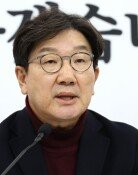3 Merger Firms Getting into the Black
Out of the `Big Deal` firms, which were merged to solve the duplicated investment after the crisis of foreign exchange, the companies manufacturing railway trains, aircraft, and marine engines are taking off.
The companies including Rotem (railcars), Korea Aerospace Industries Ltd., and HSD (marine engines), which have been cited as examples of big deal due to their accumulated debts till the early last year, are now aiming to rank high in the world through utmost efforts.
`Big Deal No.1` Rotem (former Korea Rolling Stock Corporation), which took over the railcar business of Hyundai, Daewoo and Hanjin Heavy Industry in July, 1999, once was a `trouble maker`, as it failed in attracting foreign funds, and accumulated deficits due to labor-management disputes caused by `three labor unions in one company` and the struggles for management right.
However, everything was changed when it stabilized the management by Hyundai Heavy Industry’s purchasing the equity of Daewoo (39 percent), and it managed actively changing its name to `Rotem` this year. It took the liquidation of the Busan plant of Hanjin, whose debts were going on accumulating, as a chance to stabilize the management reducing debts.
The amount of orders received is increasing as management is stabilized. The contract with India for only 240 electric trains (240 million dollars) in June was all it made last year. This year, however, the orders from foreign countries already accepted or conclusively accepted number 5 cases for over 400 million dollars including 102 electric trains (130 million dollars) with Greece.
Park Sung-Soo head of the public information division of this company said, ¡°the difficulties from low price contracts due to excessive competition among 3 companies and dull investment on social overhead capital (SOC) were completely solved. Our company will rank No. 4 in the field of railcars in 2005. ¡°
Recently, Rotem completed the development and production of `the 1st Korean-made bullet train, ` and plans to export power cars and powered-carriages of high-speed railway.
Korea Aerospace Industries Ltd (KAI), which merged aircraft business of Samsung Aerospace, Hyundai Aerospace and Daewoo Heavy Industries in October 1999, announced `10-10 Project` aiming for growing into top 10 aerospace companies by 2010. It first made 3 billion won of balance account surplus last year, and will net a profit of 11.4 billion won this year from deficit of 60 billion won last year.
The company source said that it would make a trial flight of `T50 advanced training plane` a supersonic plane developed by domestic technology for the first time. `T50 Project` is expected to be a turning point of domestic aircraft development, as it already accepted the order for around 100 planes (2 to 3 billion dollars) by 2011.
The divide of restructuring of KAI was the closure of Seosan plant in June last year, and the abandonment of B717 aircraft production business, which had yielded large-scale deficits.
HSD Engine, which has Daewoo Shipbuilding and Marine Engineering as a shareholder, launched in August, 2000 by absorbing engine production units of Doosan Heavy Industries (former Korea Heavy Industries) and Samsung Heavy Industries. HSD increased its output to 3.85 million horsepower in 2001 from yearly 1.76 million horsepower before the merger. Its management became so stable that it chooses the orders for high yielding items.
Ja-Ryong Koo bonhong@donga.com
Headline News
- Joint investigation headquarters asks Yoon to appear at the investigation office
- KDIC colonel: Cable ties and hoods to control NEC staff were prepared
- Results of real estate development diverged by accessibility to Gangnam
- New budget proposal reflecting Trump’s demand rejected
- Son Heung-min scores winning corner kick







